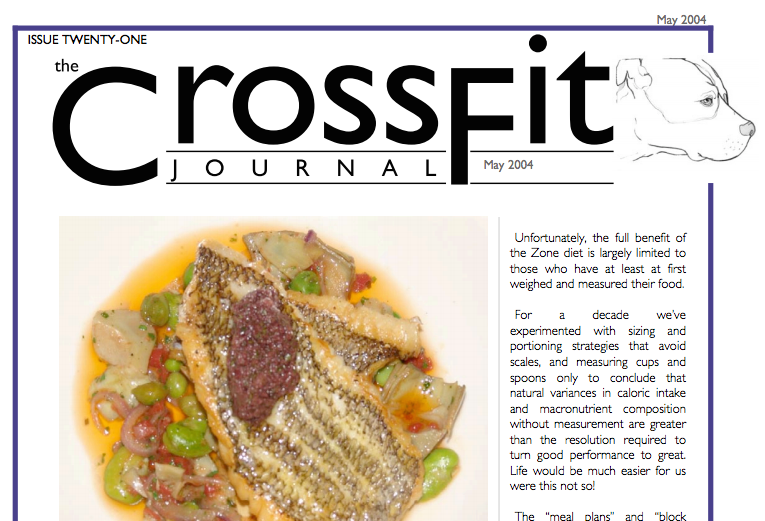[Authors Note: This is the second article in a series on the importance of a holistic approach to physical training, nutrition and spiritual strength. This article focuses on proper nutrition. For background on the context of equally dividing time spent in physical training, food preparation and development of the Warrior spirit, click here.]
The first time I heard about the Zone diet was in February 2002 from CrossFit Founder “Coach” Greg Glassman. He explained to the old-school Team 6 (the original group of athletes training with Coach Glassman at 6 a.m.) morning crew that the first athlete to start the Zone would see drastic improvement in CrossFit performance over his peers. At the time, I was serving as a deputy sheriff for the Santa Cruz County Sheriff’s Office with a goal of being selected for the SWAT Team. Fitness and health were a matter of life and death to me, so I decided to purchase the book Enter The Zone by Dr. Sears, and educate myself on the Zone diet.
Of course, reading a book and understanding it are two different things. I have to admit I was overwhelmed by the science, which explained why eating a special balance of 40% carbohydrates, 30% protein, and 30% fat would yield a balanced hormonal response with leaner muscle mass and increased athletic capacity in the gym, and in my case, on the street. The Zone also supposedly had huge benefits for long-term health (of significant importance for law enforcement is heart health) and disease resistance.
So I went to Coach and said, “Look, I want to try this diet. I need you to tell me what to eat.”
Coach patiently took the time to give me a five-day meal plan that hasn’t changed too much to this day. I am currently in my 15th year of CrossFit training and Zone-based nutrition, and the positive results continue to astonish me.
Balance—& Lots of Water
The Zone, which Dr. Sears debuted in his first book in 1995, is his term for proper hormone balance; a 40-30-30 calorie ratio of low-glycemic carbohydrates (mostly fruits and vegetables) to low-fat protein has several great effects on the body.
The first great effect is that this ratio of nutrients causes the release of moderate amounts of the hormones insulin and glucagon, which together trigger the release of a flood of feel-good chemicals called eicosanoids, which do a bunch of good things: they protect your heart (again very important, especially based on recent tragic statistics of LEO death to heart disease and stroke), open the bronchi of the lungs—and another biggie—reduce inflammation. The release of eicosanoids is literally “the Zone” that Sears talks about.
A secondary benefit of the 40-30-30 ratio important for an officers command presence is increased lean muscle mass and fat loss. That’s because moderating carbohydrate intake will moderate the levels of insulin, whose job it is to store fat. On top of that, Sears found that a body in caloric balance is more efficient at burning fat. Stored fat becomes a fuel source during high-intensity exercise, which, again, is great news for officers participating in the CrossFit workouts, and taking bad guys to jail.
Besides the 40-30-30 ratio, the other main aspect of the Zone is portion control and total calorie control. I was allotted 22 “blocks” of food a day for my size and exercise level—five four-block meals and a two-block snack. A block, under the Zone system, is a balanced unit of food, composed of the following three sub-blocks:
- Protein: 7 grams—i.e. one ounce of chicken, turkey or lean red meat; one ounce cheese; or two egg whites; high-fat meats like bacon and duck aren’t recommended;
- Carbohydrate: 9 grams—i.e. half an apple, four cups of broccoli, one kiwi; not recommended are carbs from processed grains, like bread or pasta; and
- Fat: 1.5 grams—i.e. three olives, three almonds, or a teaspoon of olive oil.
According to the Zone, “average” men and women need 14 and 11 blocks per day, respectively; a 6-foot, 185-lb. man would use 16 or 17 blocks.
Every meal, every single day, was precisely calibrated. I enjoyed the process and took great care to ensure I devoted just as much intensity and commitment to following the diet as I did during the actual CrossFit workouts. The results immediately spoke for themselves.
Within just two weeks of starting the diet, I was sprinting faster, lifting more weight, completing CrossFit workouts faster, experiencing less muscle soreness, and recovering faster between workouts. On the street, I felt energized, alert, healthy and strong. I was sleeping better, and felt more rested even when the demands of the job minimized my sleeping hours.
Taking It to the Street
Because I was serving as a deputy sheriff with the demands of patrol, court and mandatory overtime, I knew that in order to remain at the top of my game, I would need to support the effort expended during my workouts with good Zone nutrition while on-duty. How could I implement a plan to ensure that I would stay “in the Zone” while spending nearly 50 hours a week in a patrol vehicle, responding to calls for service?
A little effort and some creativity did the trick. My first priority was to invest in a good quality cooler and some Tupperware. Next, I decided to perfect five meals that would be easy to make and that would stay fresh all day in a cooler. Although the meals were by no means glamorous, they provided me with the Zone nutrition I needed and took minimal preparation time in the kitchen during the morning before leaving to work. Here is a look at the five meals I ate during the day:
Pre-Workout Snack: A Zone Bar early in the morning along with a cup of coffee before training at CrossFit gave me a 2-block snack that was just enough to carry me through a workout. I’m a big advocate for training before work. Nothing I face on the street is harder than what I’ll experience in the gym!
Then I headed home for my first full meal; breakfast.
Meal # 1: (4 blocks)
4 scrambled eggs (4 blocks of protein)
1-cup of oatmeal (4 blocks of carbohydrate)
24 almonds
(8 blocks of fat—twice the normal intake)
The next three meals were eaten while on patrol.
Meal #2: (4 blocks)
1 cup cottage cheese (4 blocks protein)
2 Fuji apples sliced into the cottage cheese (4 blocks carbohydrate)
24 almonds (2x the fat intake)
Meal #3: (4 blocks)
4 ounces of lean red meat, usually a flank steak sliced very thin (4 blocks protein)
1 cup of spaghetti with the meat stirred into the pasta (4 blocks carbohydrate—hey, I was born in Italy, give me a break!)
2 tablespoons of olive oil (2x the fat intake)
Meal #4: (4 blocks)
4 ounces of sliced cheese (4 blocks protein)
1 Fuji apple sliced thin and 1 cup of blueberries (total of 4 blocks of carbohydrate)
24 almonds (2x the fat intake)
At the end of my patrol shift, I had consumed a total of 18 blocks of food. This left me with 4 blocks to eat when I got home for dinner. I always tried to make a meal that was heavy in vegetables as the source of carbohydrate. Any shortage in carbohydrate blocks were made up for in Fuji apples.
Meal #5: (4 blocks)
4 ounces lean meat or fish (4 blocks protein)
Large salad with broccoli, tomatoes, spinach and cucumber. (4 blocks of carbohydrate)
24 almonds (2x the fat intake)
On some occasions, due to a priority call at work or a major event, I would have to work overtime without prepared meals. In those circumstances, I made a quick trip to a supermarket and purchased string cheese and apples. I always kept extra fat with me in my cooler: a ziplock bag full of almonds.
In addition to ensuring I ate in the Zone, I also drank exactly one gallon of water a day. To ensure this, I purchased a one-gallon refillable water container. This allowed me to monitor my water intake during the day. Water also helped quell any hunger pangs I felt between meals. Water makes up more than 60 percent of your body weight, and without it, you would not survive more than a few days. All of your body’s cells and organs need water to run, and water has been linked to increased energy levels, mental alertness, disease prevention, and—heart health!
After about three weeks in the Zone, I had a paradigm shift about my relationship to food. Suddenly, food existed in my life to serve a purpose. I did not care what the meals tasted like or what my peers thought of my Tupperware and lunch pail. I was on a mission to be the best Professional Warrior Athlete and cop I could be, and I knew that by eating in the Zone I would be able to optimize my results in the gym and on the street.
Conclusion
After almost 15 years of training, I’ve come to the realization that fitness and nutrition for a law enforcement officer must become a way of life. The lessons learned in a CrossFit gym, such as accountability, perseverance, dedication, and discipline, are directly applicable to life outside the gym, including the kitchen. Therefore, I find it perfectly logical that the word “diet” comes from the Greek root meaning “way of life”—and that eating in the “Zone” is a way of life that supports a healthy body, a long and safe career in Law Enforcement, and a happy retirement.
Until next time my friends, train—and eat—as if your life depends on it. Because it does!
ADDITIONAL RESOURCES











0 Comments